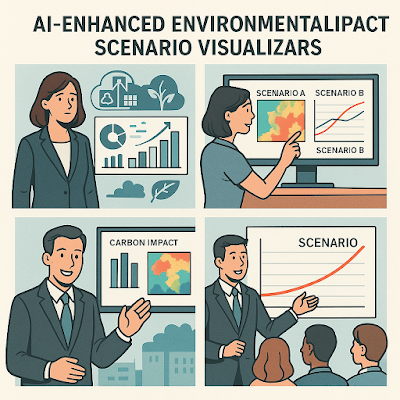How to Sell AI-Enhanced Environmental Impact Scenario Visualizers
How to Sell AI-Enhanced Environmental Impact Scenario Visualizers
Visualizing environmental impact isn’t just a reporting function—it’s a strategic capability.
With increasing pressure to meet net-zero goals, comply with ESG regulations, and prepare for climate-related disruptions, organizations need tools that can simulate multiple environmental scenarios with clarity and precision.
AI-enhanced scenario visualizers make it possible to model, compare, and communicate the outcomes of sustainability decisions across business units, cities, or supply chains.
This post explains how to sell these visualizers to the right clients with the right value narrative and feature positioning.
📌 Table of Contents
- Why Scenario Visualization Matters
- Core Features of AI-Enhanced Visualizers
- Target Markets and Buyer Personas
- Sales Messaging & Go-to-Market Strategy
- Useful Tools and External Examples
🌍 Why Scenario Visualization Matters
Stakeholders—from boardrooms to communities—are demanding clearer answers to questions like:
• What happens if we switch to renewables in our factories?
• How would water usage change if we moved our supply chain?
• What is the worst-case scenario for heatwaves on urban assets?
AI-powered visualizers allow teams to simulate and present these scenarios with interactive dashboards and spatial intelligence.
🛠️ Core Features of AI-Enhanced Visualizers
• **Geospatial Climate Modeling** – Visualizes flood, drought, wildfire, or air quality impacts by location.
• **Carbon Impact Simulations** – Models upstream/downstream emissions across supply chains and operations.
• **Regulatory Scenario Mapping** – Projects future compliance under EU Taxonomy, CSRD, or SEC climate rules.
• **What-If Engines** – Lets users adjust policy levers (e.g., fuel type, cooling systems, offsets) and see real-time effects.
🏢 Target Markets and Buyer Personas
• **Sustainability Officers** – Need scenario insights to inform climate disclosures and CSR strategy.
• **Urban Planners** – Use spatial models to assess impact of zoning or green infrastructure initiatives.
• **Supply Chain Managers** – Optimize for emissions, cost, and resilience with scenario comparisons.
• **ESG Consultants** – Offer visualizers to clients as part of impact reporting packages.
💼 Sales Messaging & Go-to-Market Strategy
1. **Visual-First Demo Culture**: Use maps, animations, and comparison timelines during sales pitches.
2. **Quantify the ROI**: Show how scenario planning reduces compliance risk, avoids reputational crises, and cuts costs.
3. **Bundle with ESG Reports**: Position visualizers as a value-add in annual sustainability reporting tools.
4. **Leverage Regulation Timing**: Target clients during ESG filing periods or pre-regulatory audit windows.
🔗 Useful Tools and External Examples
Ensure data integrity and jurisdictional compliance in scenario model pipelines.
Learn how law firms use visualizations in litigation and ESG claim defense.
Enhance proxy voting decisions using impact scenarios to shape ESG positions.
Use scenario visualizers to demonstrate carbon reduction outcomes interactively.
Keywords: ESG scenario planning, environmental visualizer tool, AI climate modeling, sustainability dashboard, regulatory compliance simulation
